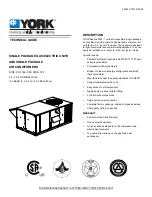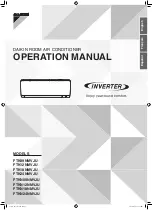
EXAMPLES
Example 1 : To automatically set both addresses of signal amplifiers and
z
indoor units
Step 1:
Activate the Signal Amplifier Automatic Address Setting function on the master
unit of Refrigerant System 1.
An address is automatically assigned to all signal amplifiers on the network.
(Because an address is also assigned to the signal amplifiers being
connected in Refrigerant Systems 2 and 3, it is not necessary to perform the
automatic address setting of these signal amplifiers again on the master units
of Refrigerant Systems 2 and 3.)
Step 2:
Activate the Indoor Unit Automatic Address Setting function on the master unit
of Refrigerant System 1.
An indoor unit address and a refrigerant circuit address are automatically set
up for all indoor units being connected in Refrigerant System 1.
Step 3:
Activate the Indoor Unit Automatic Address Setting function on the master unit
of Refrigerant System 2.
An indoor unit address and a refrigerant circuit address are automatically set
up for all indoor units being connected in Refrigerant System 2.
Step 4:
Activate the Indoor Unit Automatic Address Setting function on the master unit
of Refrigerant System 3.
An indoor unit address and a refrigerant circuit address are automatically set
up for all indoor units being connected in Refrigerant System 3.
1: If the total wiring length within a segment is expected to exceed 500 m, insert a signal amplifier (Refer to 5-3-2).
2: If the number of nodes (the number of units of indoor units, outdoor units, controllers and others) is expected to
exceed 64 (including signal amplifiers), insert a signal amplifier (Refer to 5-3-2).
Caution
Before activating the Automatic Address Setting function, make sure to finish setting the refrigerant
●
circuit addresses of outdoor units.
Setting the addresses of indoor units automatically does not necessary mean that addresses are
●
assigned sequentially starting from the indoor unit which is located the closest to the outdoor units
(instead, addresses are assigned randomly).
With respect to the setting of refrigerant circuit addresses, the same address numbers of the
refrigerant circuit addresses of the outdoor units being connected within the same refrigerant
system are assigned.
To find out what addresses have been assigned to individual indoor units, it is necessary to
●
perform a separate address check operation.
2
1
2
12
8
21
4
1
1
2
3
3
3
3
3
3
3
3
3
3
3
3
2
2
2
2
2
2
2
2
2
2
2
1
1
1
1
1
1
1
1
1
1
1
26
3
1
4
25
6
8
17
12
18
1
10
23
4
22
18
3
11
28
8
9
*1
*2
Refrigerant system1
Refrigerant system2
Refrigerant system3
Master unit
Master unit
Master unit
Signal amplifier
Signal amplifier
Indoor unit address No.
Refrigerant circuit address No.
Indoor unit address No.
Indoor unit address No.
Refrigerant circuit address No.
Refrigerant circuit address No.
- (06 - 99) -
SY
ST
EM
DE
SIGN
SY
ST
EM
DE
SIGN
Summary of Contents for AIRSTAGE V-II
Page 10: ...1 GENERAL INFORMATION ...
Page 32: ...2 MODEL SELECTION ...
Page 207: ...3 OUTDOOR UNITS ...
Page 251: ...SOUND LEVEL CHECK POINT Microphone 1 m 1 m 03 44 OUTDOOR UNITS OUTDOOR UNITS ...
Page 265: ...4 INDOOR UNITS ...
Page 315: ...MODEL ARXB45 04 50 INDOOR UNITS INDOOR UNITS ...
Page 316: ...4 5 5 DUCT TYPE MODEL ARXA24 MODELS ARXA30 ARXA36 ARXA45 04 51 INDOOR UNITS INDOOR UNITS ...
Page 318: ...4 5 7 FLOOR CEILING TYPE MODELS AB A12 AB A14 AB A18 AB A24 04 53 INDOOR UNITS INDOOR UNITS ...
Page 319: ...4 5 8 CEILING TYPE MODELS AB A30 AB A36 AB A45 AB A54 04 54 INDOOR UNITS INDOOR UNITS ...
Page 322: ...4 5 11 WALL MOUNTED TYPE MODELS AS A18 AS A24 AS A30 04 57 INDOOR UNITS INDOOR UNITS ...
Page 388: ...5 CONTROL SYSTEM ...
Page 472: ...6 SYSTEM DESIGN ...
Page 694: ...7 OPTIONAL PARTS ...
















































